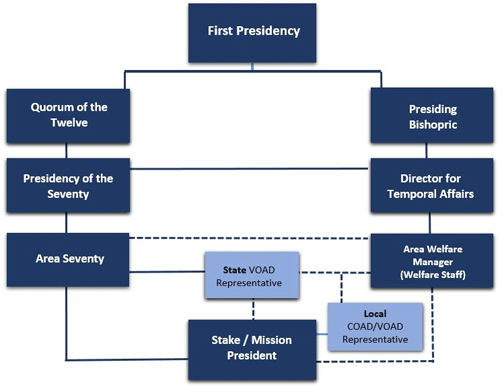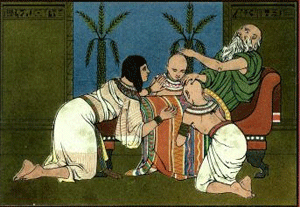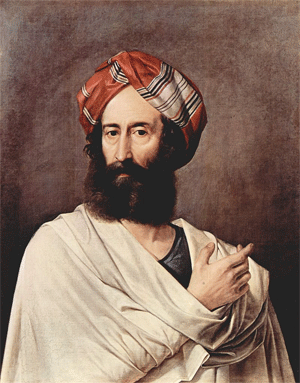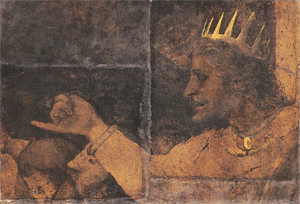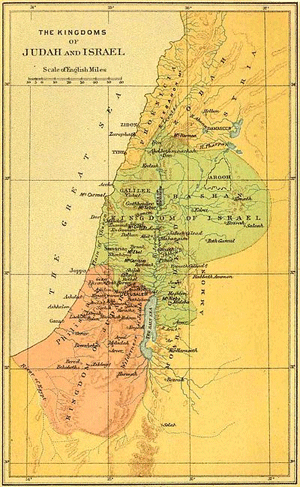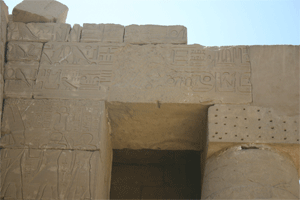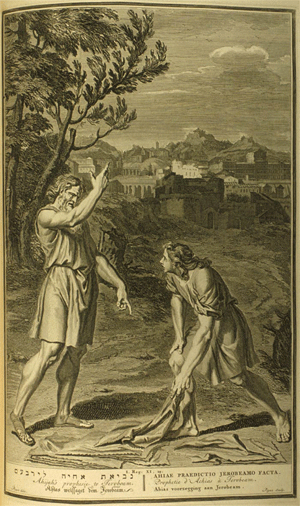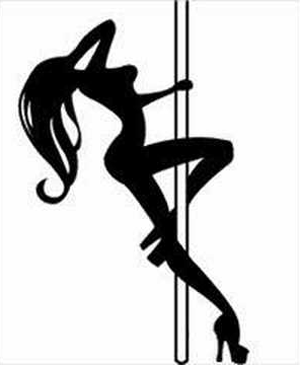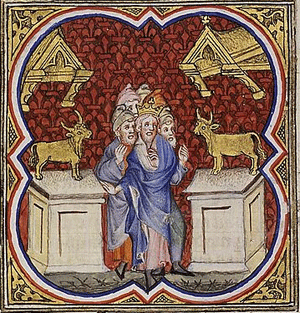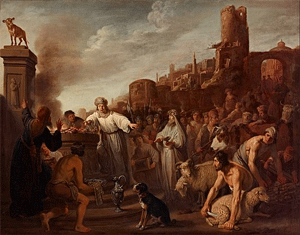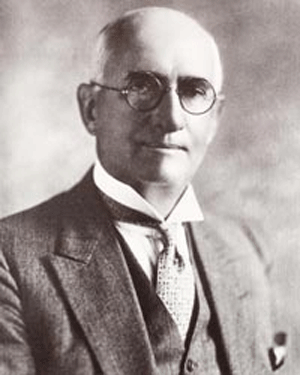Sacred prostitutionby Wikipedia
Accessed: 7/18/18
NOTICE: THIS WORK MAY BE PROTECTED BY COPYRIGHTYOU ARE REQUIRED TO READ
THE COPYRIGHT NOTICE AT THIS LINK BEFORE YOU READ THE FOLLOWING WORK, THAT IS AVAILABLE SOLELY FOR PRIVATE STUDY, SCHOLARSHIP OR RESEARCH PURSUANT TO 17 U.S.C. SECTION 107 AND 108. IN THE EVENT THAT THE LIBRARY DETERMINES THAT UNLAWFUL COPYING OF THIS WORK HAS OCCURRED, THE LIBRARY HAS THE RIGHT TO BLOCK THE I.P. ADDRESS AT WHICH THE UNLAWFUL COPYING APPEARED TO HAVE OCCURRED. THANK YOU FOR RESPECTING THE RIGHTS OF COPYRIGHT OWNERS.
Sacred prostitution, temple prostitution, cult prostitution,[1] and religious prostitution are general terms for a sexual rite consisting of sexual intercourse or other
sexual activity performed in the context of religious worship, perhaps as a form of fertility rite or divine marriage (hieros gamos). Some scholars prefer the term sacred sex to sacred prostitution in cases where payment for services was not involved.
Ancient Near East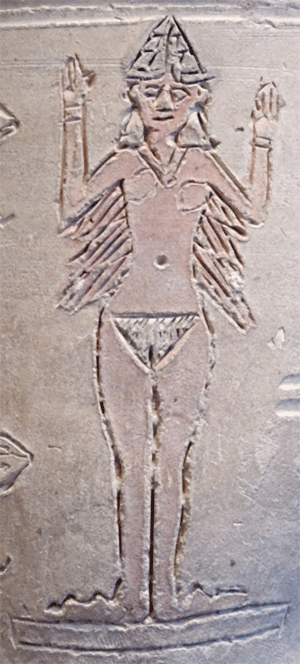 Inanna/Ishtar depicted wearing the ceremonial headdress of the high priestess
Inanna/Ishtar depicted wearing the ceremonial headdress of the high priestessAncient Near Eastern societies along the Tigris and Euphrates rivers featured many shrines and temples or houses of heaven dedicated to various deities. The 5th-century BC historian
Herodotus's account and some other testimony from the Hellenistic Period and Late Antiquity suggest that ancient societies encouraged the practice of sacred sexual rites not only in Babylonia and Cyprus, but throughout the Near East.
According to Herodotus, the rites performed at these temples included sexual intercourse, or what scholars later called sacred sexual rites:
The foulest Babylonian custom is that which compels every woman of the land to sit in the temple of Aphrodite and have intercourse with some stranger at least once in her life. Many women who are rich and proud and disdain to mingle with the rest, drive to the temple in covered carriages drawn by teams, and stand there with a great retinue of attendants. But most sit down in the sacred plot of Aphrodite, with crowns of cord on their heads; there is a great multitude of women coming and going; passages marked by line run every way through the crowd, by which the men pass and make their choice. Once a woman has taken her place there, she does not go away to her home before some stranger has cast money into her lap, and had intercourse with her outside the temple; but while he casts the money, he must say, "I invite you in the name of Mylitta". It does not matter what sum the money is; the woman will never refuse, for that would be a sin, the money being by this act made sacred. So she follows the first man who casts it and rejects no one. After their intercourse, having discharged her sacred duty to the goddess, she goes away to her home; and thereafter there is no bribe however great that will get her. So then the women that are fair and tall are soon free to depart, but the uncomely have long to wait because they cannot fulfil the law; for some of them remain for three years, or four. There is a custom like this in some parts of Cyprus.[2]
The British anthropologist James Frazer accumulated citations to prove this in a chapter of his magnum opus The Golden Bough (1890–1915),[3] and this has served as a starting point for several generations of scholars. Frazer and Henriques distinguished two major forms of sacred sexual rites: temporary rite of unwed girls (with variants such as dowry-sexual rite, or as public defloration of a bride), and lifelong sexual rite.[4] However, Frazer took his sources mostly from authors of Late Antiquity (i.e. 150–500 AD), not from the Classical or Hellenistic periods.[5] This raises questions as to whether the phenomenon of temple sexual rites can be generalized to the whole of the ancient world, as earlier scholars typically did.
The research of Daniel Arnaud, Vinciane Pirenne-Delforge, Julia Assante, Stephanie Budin[6] and others has cast the whole tradition of scholarship that defined the concept of sacred prostitution into doubt. Budin regards the concept of sacred prostitution as a myth—arguing that the practices described in the sources simply never existed. A more nuanced view, espoused by Pirenne-Delforge, suggests that ritual sex did exist in the Near East, but not in the Greek or Roman worlds in classical or Hellenistic times.[6]
Sacred marriageThe practice of sacred prostitution has not been substantiated in any Ancient Near Eastern cultures, despite many popular descriptions of the habit.[7] Through the twentieth century, scholars generally believed that a form of sacred marriage rite or hieros gamos was staged between the king of a Sumerian city-state and the High Priestess of Inanna, the Sumerian goddess of sexual love, fertility, and warfare, but no certain evidence has survived to prove that sexual intercourse was included. Along the Tigris and Euphrates rivers there was a temple of Eanna, meaning house of heaven[8] dedicated to Inanna in the Eanna District of Uruk.[9]
While there may well have been some religious prostitution in the temples of Inanna/Ishtar, Assante suggests the concept of the 'sacred marriage' (hieros gamos) has been misunderstood. It was previously believed to have been a custom whereby the king coupled with the high priestess to represent the union of Dumuzid with Inanna (later called Ishtar).[10] It is much more likely that these unions never occurred but were embellishments to the image of the king; hymns which praise Middle Eastern kings for coupling with the goddess Ishtar often speak of him as running 320 kilometres, offering sacrifices, feasting with the sun-god Utu, and receiving a royal crown from An, all in a single day. One scholar comments: "No one, to the best of my knowledge, has been so wooden-minded to propose that human actors played the role of Utu and An at the banquet."[11] Not all authors are convinced, however.[10]
Other modern historians argue that the temple did house priestesses of the goddess, but there is no evidence that they performed any kind of sexual services in any cult.[12][13][14][15]
Code of HammurabiIn Hammurabi's code of laws, the rights and good name of female sacred sexual priestesses were protected. The same legislation that protected married women from slander applied to them and their children. They could inherit property from their fathers, collect income from land worked by their brothers, and dispose of property. These rights have been described as extraordinary, taking into account the role of women at the time.[16]
Hebrew BibleThe Hebrew Bible uses two different words for prostitute, zonah (זונה)[17] and kedeshah (or qedesha) (קדשה).[17] The word zonah simply meant an ordinary prostitute or loose woman.[17] But the word kedeshah literally means consecrated (feminine form), from the Semitic root q-d-sh (קדש) meaning holy or set apart.[17] In spite of the cultic significance of a kedeshah to a follower of the Canaanite religion,
the Hebrew Bible makes it clear that cultic prostitution had no place in Israelite or Judahite religion. Thus the Hebrew version of Deuteronomy 23:17-18 tells followers:
None of the daughters of Israel shall be a kedeshah, nor shall any of the sons of Israel be a kadesh.
You shall not bring the hire of a prostitute (zonah) or the wages of a dog (kelev) into the house of the Lord your God to pay a vow, for both of these are an abomination to the Lord your God.
Stephen O. Murray writes that biblical passages ban qdeshim and link them with gods and "forms of worship detested by orthodox followers of Yahweh".[18] Celia Brewer Sinclair has written that "the ethical demands of the covenant preclude worshiping Yahweh in licentious sexual rites (sacred sexual rites )".[19]
Male priests who engaged in same-sex sacred prostitution were called kadesh or qadesh (literally: male holy one); the word evolved semantically in ancient Hebrew to take on a similar meaning to sodomite.[20] The Hebrew word kelev (dog) in the next line may also signify a male dancer or prostitute.[21] Some scholars see the injunctions against foreign worship, including male sacred prostitution, as possibly the original cause of what would later become Judaism's condemnation of sexual contact between men.[20] However, there are multiple examples of condemnation and instructions against male same-sex intercourse (e.g., Sodom and Gomorrah, Leviticus 20:13) in the Torah that predate Judaism.In the Book of Ezekiel, Oholah and Oholibah appear as the allegorical brides of God who represent Samaria and Jerusalem. They became prostitutes in Egypt, engaging in prostitution from their youth. Ezekiel condemns both as guilty of religious and political alliance with heathen nations.[22]
SumerAccording to the noted Assyriologist Samuel Noah Kramer, kings in the ancient Near Eastern region of Sumer established their legitimacy by taking part in a ritual sexual act in the temple of the fertility goddess Ishtar every year on the tenth day of the New Year festival Akitu.[23]
HittitesThe Hittites practiced sacred prostitution as part of a cult of deities, including the worship of a mated pair of deities, a bull god and a lion goddess, while in later days it was the mother-goddess who became prominent, representing fertility, and (in Phoenicia) the goddess who presided over human birth.[24]
Ancient Greece and Hellenistic World
Ancient GreeceIn ancient Greece, sacred prostitution was known in the city of Corinth where the temple of Aphrodite employed a significant number of female servants, hetairai, during classical antiquity.[25]
The Greek term hierodoulos or hierodule has sometimes been taken to mean sacred holy woman, but it is more likely to refer to a former slave freed from slavery in order to be dedicated to a god.[6]
Hellenistic worldIn the Greek-influenced and colonized world, "sacred prostitution" was known in Cyprus (Greek-settled since 1100 BC), Sicily (Hellenized since 750 BC), in the Kingdom of Pontus (8th century BC) and in Cappadocia (c. 330 BC hellenized).
Ancient Rome and late antiquity
Ancient Rome
Late antiquityThe Roman emperor Constantine closed down a number of temples to Venus or similar deities in the 4th century AD, as the Christian church historian Eusebius proudly noted.[26] Eusebius also claimed that the Phoenician cities of Aphaca and Heliopolis (Baalbek) continued to practise temple prostitution until the emperor Constantine put an end to the rite in the 4th century AD.[26]
Asia
IndiaIn Southern India and the eastern Indian state of Odisha, devadasi is the practice of hierodulic prostitution, with similar customary forms such as basavi,[27] and involves dedicating pre-pubescent and young adolescent girls from villages in a ritual marriage to a deity or a temple, who then work in the temple and function as spiritual guides, dancers, and prostitutes servicing male devotees in the temple. Human Rights Watch reports claim that devadasis are forced into this service and, at least in some cases, to practice prostitution for upper-caste members.[28] Many scholars maintain that the devadasi system is not described in the holy scriptures of Hinduism as the scriptures do not refer to any form of sacred prostitution or temple girls.[29] Whether the devadasi girls engaged in sexual services is debated, however, as temple visitors touching or speaking to the girls was considered an offence.[29]
Various state governments in India enacted laws to ban this practice both prior to India's independence and more recently. They include Bombay Devdasi Act, 1934, Devdasi (Prevention of dedication) Madras Act, 1947, Karnataka Devdasi (Prohibition of dedication) Act, 1982, and Andhra Pradesh Devdasi (Prohibition of dedication) Act, 1988.[30] However, the tradition continues in certain regions of India, particularly the states of Karnataka and Andhra Pradesh.[31]IslamSexual slavery as concubinage in Islamic sexual jurisprudence is permitted in Islam which was not considered prostitution, and was very common during the Arab slave trade throughout the Middle Ages and early modern period, when women and girls from the Caucasus, Africa, Central Asia and Europe were captured and served as concubines in the harems of the Arab World.[32] Ibn Battuta tells us several times that he was given or purchased female slaves.[33]Concubinage in Islam is permitted. "Concubine" (surriyya) refers to the female slave (jāriya), whether Muslim or non-Muslim, with whom her master engages in sexual intercourse. The word "surriyya" is not mentioned in the Qur'an. However, the expression "Ma malakat aymanukum" (that which your right hands own), which occurs fifteen times in the sacred book, refers to slaves and therefore, though not necessarily, to concubines. Concubinage was a pre-Islamic custom that was allowed to be practiced under Islam with Jews and non-Muslim people to marry concubine after teaching her and instructing her well and then giving them freedom.[34] Rationale given for recognition of concubinage in Islam is that "it satisfied the sexual desire of the female slaves and thereby prevented the spread of immorality in the Muslim community."[35] Most schools restrict concubinage to a relationship where the female slave is required to be monogamous to her master[36] (though the master's monogamy to her is not required), but according to Sikainga,
"in reality, however, female slaves in many Muslim societies were prey for [male] members of their owners' household, their [owner's male] neighbors, and their [owner's male] guests."[35]
According to Shia Muslims, Muhammad sanctioned Nikah mut‘ah (fixed-term marriage, called muta'a in Iraq and sigheh in Iran) which has instead been used as a legitimizing cover for sex workers, in a culture where prostitution is otherwise forbidden.[37] Some Western writers have argued that mut'ah approximates prostitution.[38] and Nikah misyar[39] Julie Parshall writes that mut'ah is legalised prostitution which has been sanctioned by the Twelver Shia authorities. She quotes the Oxford encyclopedia of modern Islamic world to differentiate between marriage (nikah) and Mut'ah, and states that while nikah is for procreation,
mut'ah is just for sexual gratification.[40] According to Zeyno Baran, this kind of temporary marriage provides Shi'ite men with a religiously sanctioned equivalent to prostitution.[41] According to Elena Andreeva's observation published in 2007, Russian travellers to Iran consider mut'ah to be "legalized profligacy" which is indistinguishable from prostitution.[42] Religious supporters of mut'ah argue that temporary marriage is different from prostitution for a couple of reasons, including the necessity of iddah in case the couple have sexual intercourse. It means that if a woman marries a man in this way and has sex, she has to wait for a number of months before marrying again and therefore, a woman cannot marry more than 3 or 4 times in a year.[43][44][45][46][47][48]
Mesoamerica and South AmericaThe Maya maintained several phallic religious cults, possibly involving homosexual temple prostitution.[49][50]
The Aztec god Xochipili (taken from both Toltec and Maya cultures) was both the patron of homosexuals and homosexual prostitutes.[50][51][52][53] The Inca sometimes dedicated young boys as temple prostitutes. The boys were dressed in girl's clothing, and chiefs and head men would have ritual sexual intercourse with them during religious ceremonies and on holy days.[54][55]Xochiquetzal was worshiped as goddess of sexual power, patroness of prostitutes and artisans involved in the manufacture of luxury items.[56]
The conquistadores were horrified by the wide-spread acceptance of homosexuality, ephebophilia, pederasty, and pederosis among Mesoamerican and South American peoples, and used torture, burning at the stake, mass beheadings, and other means to stamp it out both as a religious practice and social custom.[50]Recent Western occurrencesIn the 1970s and early 1980s, some religious cults practiced
sacred prostitution as an instrument to recruit new converts. Among them was the alleged cult Children of God, also known as The Family, who called this practice "Flirty Fishing". They later abolished the practice due to the growing A.I.D.S. epidemic.[57]
In Ventura County, California, Wilbur and Mary Ellen Tracy established their own temple, the Church Of The Most High Goddess, in the wake of what they described as a divine revelation. Sexual acts played a fundamental role in the church's sacred rites, which were performed by Mary Ellen Tracy herself in her assumed role of High Priestess.[58] Local newspaper articles about the Neopagan church quickly got the attention of local law enforcement officials, and in April 1989, the Tracys' house was searched and the couple arrested on charges of pimping, pandering and prostitution. They were subsequently convicted in a trial in state court and sentenced to jail terms: Wilbur Tracy for 180 days plus a $1,000.00 fine; Mary Ellen Tracy for 90 days plus mandatory screening for STDs.[59][60]
See also• Deuki
• Sex worker
• Sex magic
• Devadasi
• Primitive promiscuity
• Hetaera
• Hijra (South Asia)
• Sexuality in ancient Rome
• List of fertility deities
• List of love and lust deities
References1. Schulz, Matthias (2010-03-26). "Sex in the Service of Aphrodite: Did Prostitution Really Exist in the Temples of Antiquity?". Spiegel Online. Retrieved 2016-01-01.
2. Herodotus, The Histories 1.199, tr A.D. Godley (1920)
3. J.G. Frazer, The Golden Bough, abridged edition (1922), Chapter 31: Adonis in Cyprus; see also the more extensive treatment in the 3rd edition of The Golden Bough, volumes 5 and 6 (published 1914). Frazer's argument and citations are reproduced in slightly clearer fashion by Fernando Henriques, Prostitution and Society: a study (3 vols., London : MacGibbon & Kee, 1962–1968), vol. I, ch. 1.
4. Fernando Henriques, Prostitution and Society: a study (3 vols., London : MacGibbon & Kee, 1962–1968), vol. I, ch. 1.
5. Herodotus and Strabo are the only sources mentioned by Frazer that were active prior to the 2nd century AD; his other sources include Athenaeus, pseudo-Lucian, Aelian, and the Christian church historians Sozomen and Socrates of Constantinople.
6. Stephanie Budin, The Myth of Sacred Prostitution in Antiquity (Cambridge University Press, 2009); more briefly the case that there was no sacred prostitution in Greco-Roman Ephesus by S.M. Baugh (1999)
http://www.etsjets.org/files/JETS-PDFs/ ... _JETS.pdf; see also the book review by Vinciane Pirenne-Delforge, Bryn Mawr Classical Review, April 28, 2009.
7. James Frazer (1922), The Golden Bough, 3e, Chapter 31: Adonis in Cyprus
8. é-an-na = sanctuary ('house' + 'Heaven'[='An'] + genitive) [John Halloran's Sumerian Lexicon v. 3.0 – see link below]
9. Modern-day Warka, Biblical Erech.
10. John Day, "Does the Old Testament Refer to Sacred Prostitution and Did it Actually Exist in Ancient Israel?", in Biblical and Near Eastern Essays: Studies in Honour of Kevin J. Cathcart, eds. Carmel McCarthy & John F Healey (Continuum International Publishing, 2004), 2–21.
11. Sweet, R. "A New Look at the 'Sacred Marriage' in Ancient Mesopotamia", in E. Robbins and S. Sandahl, eds., Corolla Torontonensis. Studies in Honour of Ronald Morton Smith (Toronto, 1994) 85–104.
12. Budin, Stephanie Lynn, The Myth of Sacred Prostitution in Antiquity
13. Assante, Julia 1998. "The kar.kid/[kh]arimtu, Prostitute or Single Woman? A Reconsideration of the Evidence", Ugarit-Forschungen; 30:5–96
14. Assante, Julia 2003. "From Whores to Hierodules: the Historiographic Invention of Mesopotamian Female Sex Professionals", pp. 13–47 in Ancient Art and Its Historiography, edited A. A. Donahue and Mark D. Fullerton. Cambridge/New York: Cambridge University
15. Yamauchi, Edwin M. 1973. "Cultic Prostitution: a Case Study in Cultural Diffusion", pp. 213–222 in Orient and Occident: Essays Presented to Cyrus H. Gordon, edited H. Hoffner. Neukirchen-Vluyn, Germany: Kevelaer
16. The Sacred Prostitute: Eternal Aspect of the Feminine By Nancy Qualls-Corbett
17. Associated with the corresponding verb zanah."Genesis 1:1 (KJV)". Blue Letter Bible. Retrieved 5 April 2018. incorporating Strong's concordance (1890) and Gesenius's Lexicon (1857). Also transliterated qĕdeshah, qedeshah, qědēšā,qedashah, kadeshah, kadesha, qedesha, kdesha. A modern liturgical pronunciation would be k'deysha.
18. Murray, Stephen O. (2002). Homosexualities. University of Chicago Press. p. 295.
19. Sinclair, Mashal; Brewer, Celia (1989). A Guide Through the Old Testament. Westminster John Knox Press. p. 71.
20. "A History of Homophobia: 1 The Ancient Hebrews". Retrieved 18 May 2015.
21. Lexicon results for kelev (Strong's H3611), incorporating Strong's Concordance(1890) and Gesenius's Lexicon (1857).
22. "NETBible: Oholibah". Retrieved 18 May 2015.
23. S. N. Kramer, The Sacred Marriage Rite: Aspects of Faith, Myth and Ritual in Ancient Sumer.
24. Nagendra Kr Singh, Divine Prostitution page 6, (1997)
25. Strabo. "Geographica". VIII.6.20.
26. Eusebius, Life of Constantine, 3.55 and 3.58
27. "What is child hierodulic servitude?". Anti-Slavery Society. Archived from the original on 2 January 2016. Retrieved 5 April 2018.
28. Human Rights Watch. Caste: Asia's Hidden Apartheid
29.
http://www.samarthbharat.com/files/devadasihistory.pdf30. United Nations Committee on the Elimination of Discrimination against Women. Thirty-seventh session: 15 January – 2 February 2007
31. "`Project Combat' launched to eradicate `Devadasi' system". The Hindu. 2006-01-30. Retrieved 2007-01-31.
32. "BBC - Religions - Islam: Slavery in Islam". Retrieved 11 December 2016.
33. Insights into the concept of Slavery Archived 2009-11-22 at the Wayback Machine.. San Francisco Unified School District.
34. "Al-Adab Al-Mufrad / Book-9 / Hadith-48". quranx.com. Retrieved 7 June 2015.
35. Sikainga, Ahmad A. (1996). Slaves Into Workers: Emancipation and Labor in Colonial Sudan. University of Texas Press. ISBN 0-292-77694-2. p.22
36. Bloom, Jonathan; Blair, Sheila (2002). Islam: A Thousand Years of Faith and Power. Yale University Press. ISBN 0-300-09422-1. p.48
37. İlkkaracan, Pınar (2008). Deconstructing sexuality in the Middle East: challenges and discourses. Ashgate Publishing, Ltd. p. 36. ISBN 0-7546-7235-2.
38. Meri, Josef W.; Bacharach, Jere L. (1 January 2006). Medieval Islamic Civilization: L-Z, index. Taylor & Francis. ISBN 9780415966924.
39. Pohl, Florian (1 September 2010). Muslim World: Modern Muslim Societies. Marshall Cavendish. pp. 52–53. Retrieved 5 April 2013.
40. Parshall, Philip L.; Parshall, Julie (1 April 2003). Lifting the Veil: The World of Muslim Women. InterVarsity Press. ISBN 9780830856961.
41. Baran, Zeyno (21 July 2011). Citizen Islam: The Future of Muslim Integration in the West. A&C Black. ISBN 9781441112484.
42. Andreeva, Elena (2007). Russia and Iran in the great game: travelogues and Orientalism. Routledge studies in Middle Eastern history. 8. Psychology Press. pp. 162–163. ISBN 0415771536. "Most of the travelers describe the Shi'i institution of temporary marriage (sigheh) as 'legalized profligacy' and hardly distinguish between temporary marriage and prostitution."
43. Temporary Marriage in Islam Part 6: Similarities and Differences of Mut’a and Regular Marriage | A Shi'ite Encyclopedia | Books on Islam and Muslims | Al-Islam.org. Permanent archived link.
44. "Iddah Of Mutah". ShiaChat.com.
45. "Marriage » Mut'ah (temporary marriage) - Islamic Laws - The Official Website of the Office of His Eminence Al-Sayyid Ali Al-Husseini Al-Sistani".
http://www.sistani.org.
46. "The Rules in Matrimony and Marriage". Al-Islam.org.
47. "How is Mutah different from prostitution (from a non-Muslim point of view)?". islam.stackexchange.com.
48. "Marriage". english.bayynat.org.lb.
49. Thompson, John Eric Sidney. The Rise and Fall of Maya Civilization. 2d ed. Norman, Okla.: University of Oklahoma Press, 1973. ISBN 0-8061-0301-9
50. Greenberg, David. The Construction of Homosexuality. Chicago: University of Chicago Press, 1990. ISBN 0-226-30628-3
51. Diaz del Castillo, Bernal. The True History of the Conquest of New Spain. Robert Bontine Cunninghame Graham, ed. Cambridge, Mass.: Library Reprints, 2008. ISBN 1-4227-8345-6; Trexler, Richard C. Sex and Conquest: Gendered Violence, Political Order, and the European Conquest of the Americas. Paperback ed. Ithaca, N.Y.: Cornell University Press, 1999. ISBN 0-8014-8482-0; Keen, Benjamin. The Aztec Image in Western Thought. Paperback ed. New Brunswick, N.J.: Rutgers University Press, 1991. ISBN 0-8135-1572-6; Idell, Albert. The Bernal Diaz Chronicles. New York: Doubleday, 1956.
52. Mendelssohn, Kurt. Riddle of the Pyramids. Paperback ed. New York: Thames & Hudson Ltd., 1986. ISBN 0-500-27388-X; Estrada, Gabriel S. "An Aztec Two-Spirit Cosmology: Re-sounding Nahuatl Masculinities, Elders, Femininities, and Youth." Frontiers: A Journal of Women Studies. 24:2 & 3 (2003).
53. Taylor, Clark L. "Legends, Syncretism, and Continuing Echoes of Homosexuality from Pre-Columbian and Colonial Mexico." In Male Homosexuality in Central and South America. Paperback ed. Stephen O. Murray, ed. San Francisco: Instituto Obregon, 1987. ISBN 0-942777-58-1
54. Guerra, Francisco. The Pre-Columbian Mind. Burlington, Mass.: Academic Press, Inc., 1971. ISBN 0-12-841050-7
55. Flornoy, Bertrand. The World of the Incas. Trans. by Winifred Bradford. New York: Vanguard Press, 1956; Scott, George Ryley. Phallic Worship. London, Luxor, 1966; Brundage, Burr Cartwright. Lords of Cuzco: A History and Description. Norman, Okla.: University of Oklahoma Press, 1967; Murra, Victor. The Economic Organization of the Inka State. Greenwich, Conn.: JAI Press, 1980. ISBN 0-89232-118-0.
56. Clendinnen (1991, p.163); Miller & Taube (1993, p.190); Smith (2003, p.203)
57. Williams, Miriam (1998). Heaven's Harlots. New York: William Morrow/ Harper Collins. p. 320. ISBN 978-0-688-17012-7.
58. "Church uses Sex to save Sinners!". Weekly World News. 6 June 1989. p. 17. Retrieved 18 May 2015.
59. "Religion Based On Sex Gets A Judicial Review". New York Times. 2 May 1990. Retrieved 24 November 2015.
60. "Star-News - Google News Archive Search". Retrieved 18 May 2015.
Further reading• Henriques, Fernando, Prostitution and Society, 3 vols. (London : MacGibbon & Kee, 1962-1968), vol. I: "Primitive, Classical and Oriental".
• Cleugh, James Oriental Orgies: an account of some erotic practices among non-Christians. London: Anthony Blond, 1968
External links• Stuckey, H. Johanna. "Sacred Prostitutes". MatriFocus. 2005 vol 5-1.
• Deuteronomy 23:18-19, and a discussion
• Jenin Younes (2008), Sacred Prostitution in Ancient Israel
